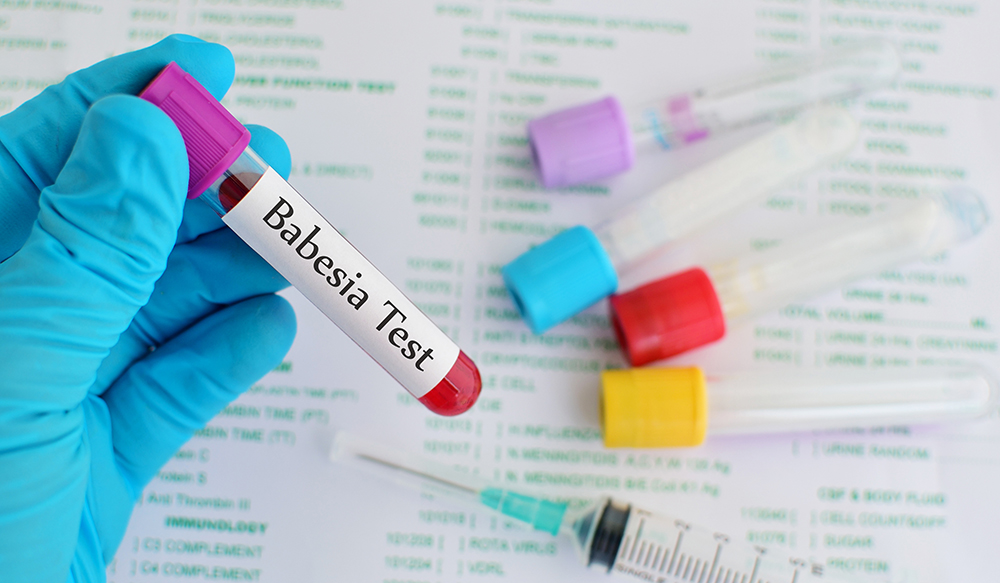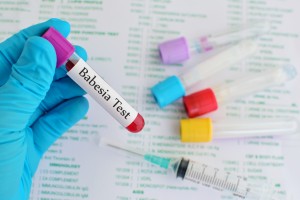Babesia and Lyme — it’s worse than you think

Babesia, a tick-borne infection that causes malaria-like symptoms, has been making headlines over the past two years as the number of reported cases increases, and concerns grow over the seriousness of the disease and its ability to be transmitted through the blood supply.
Although Lyme disease is the most talked about tick-transmitted disease, Babesia is more common than you might think. In the 2015 issue of Trends in Parasitology, Diuk-Wasser and colleagues report that up to 40% of patients with Lyme disease experienced concurrent Babesiosis. [1]
This means that out of the estimated 300,000 cases of Lyme disease reported annually in the U.S., 120,000 of those individuals may also have Babesia. This is particularly alarming given that the disease can go undetected in asymptomatic individuals and is transmissible through blood transfusions or congenitally. Additionally, Babesia requires different treatment than Lyme disease.
The Babesia microti (B. microti) parasite that leads to Babesia is commonly seen in blacklegged deer ticks. But according to the authors, it’s also common to find ticks and enzootic hosts carrying both Borrelia burgdorferi (the causative agent of Lyme disease) and B. microti. In fact, between 12% and 42% of rodents are co-infected with both agents. This would suggest that “coinfection provides a survival advantage for both pathogens.” [1]
The first case of Babesiosis caused by the B. microti parasite was identified in 1969 in an individual who had vacationed in Massachusetts. It wasn’t until 2011, that it became a nationally notifiable disease with more than 1100 cases reported by the Centers for Disease Control and Prevention (CDC). Two years later, this number had risen to nearly 1800.
Setty and colleagues summarized their concern in a 2003 review, “Parasitemia in humans is transient and episodic. For this reason, there is a risk of asymptomatic donors transmitting the disease to recipients.” The authors raised concerns that there were 20 cases of Babesiosis and a variant Babesia strain called WA1 by red blood cells and blood component transfusions by 2003.
Babesia can lead to serious illness. Patients have presented with atrial fibrillation, [2] noncardiogenic pulmonary edema, [3] and anemia. [2] In New York, between 1982 and 1991, 7 people with Babesia died, while another patient on Nantucket Island developed pancarditis and died. [4]
Babesia occurs in individuals without the risk factors of increased age, prior splenectomy, immunosuppression, prematurity, and liver disease. [2] In one study of 192 patients, the average age was 46 years for individuals with Babesia. [5] The ages ranged from 27 to 83 years in a New York case series. [6] Five of 192 patients were immunosuppressed, [5] while none of the four subjects in another study had a splenectomy. [2]
Babesia can increase the severity of Lyme disease. Coinfected patients were more likely to have experienced fatigue, headache, sweats, chills, anorexia, emotional lability, nausea, conjunctivitis, and splenomegaly more frequently than those with Lyme disease alone. [7]
Babesia can also increase the duration of illness with Lyme disease. Babesia patients can remain symptomatic for years with constitutional, musculoskeletal, or neurological symptoms. One study found that 50% of coinfected patients were symptomatic for 3 months or longer, compared to only 4% of patients who had Lyme disease alone. [7] Meanwhile, one-third of patients with a history of both Babesia and Lyme disease remained symptomatic an average of 6 years. [2]
“The clinical pictures for 3 out of our 4 coinfected patients included a large number of symptoms, and 1 coinfected patient had persistent fatigue after treatment,” according to a study by Steere and colleagues. [8] [bctt tweet=”Babesia and Lyme — it’s worse than you think” username=”DrDanielCameron”]
Babesia – difficult to diagnose
Equally worrisome is the fact that the disease can be difficult to diagnose based on symptoms. Nearly all patients with Babesia reported sweats. However, if the patient was coinfected with Lyme disease, the incidence of sweats dropped to 42%. Sweats can also be reported in other tick borne illnesses. [5]

The Babesia tests can become negative. The Babesia sporozoites can be too few in number to be detected on a thin smear or can resolve with or without treatment. It’s been reported that a positive serologic test for B. microti will decay over time, leading to a negative test. Half of the patients with positive serologic tests for B. microti were negative on follow-up. [2]
Treating Babesia
Babesia cannot be treated with the same medications used to treat Lyme disease. Doxycycline is effective for Lyme disease, Ehrlichia, and Anaplasmosis but not for Babesia. Treatment with Mepron and Zithromax has been effective for Babesia. Quinine and clindamycin have also been effective but are associated with a higher rate of side effects. Flagyl and Tindamax drugs have been proposed but not well studied. The optimal treatment for Babesia has yet to be worked out.
Physicians have different views over the diagnosis and treatment of Babesia. The Infectious Diseases Society of America’s (IDSA) guidelines advise:
- Symptomatic patients whose serum contains antibody to Babesia but whose blood lacks identifiable Babesia parasites on smear or Babesia DNA by PCR should not receive treatment.
- Treatment is also not recommended for asymptomatic individuals, regardless of the results of serologic examination, blood smears, or PCR.
- Asymptomatic patients with positive Babesial smears and/or PCR should have these studies repeated, and a course of treatment should be considered if Parasitemia persists for >3 months. [9]
There are physicians who have elected not to treat Babesia patients, who are asymptomatic. In 1998, Krause and colleagues reported, “24 of 46 Babesia-infected subjects, who received no specific treatment, had Babesia DNA detectable in their blood for an average of 82 days.” [10]
In 2002, Krause et al reported, “Because symptoms had resolved or improved by the time concurrent Babesiosis or HGE was diagnosed, therapy was not administered to 38 (58%) of the patients with Lyme disease plus Babesiosis.” [5]
There are physicians concerned that symptoms of Babesia may be overlooked when evaluating patients. [11] The symptoms of chronic Lyme disease were overlooked for up to 14 years until reported in the 1990 New England Journal of Medicine by Logigian et al. [12] Meanwhile, the symptoms of Lyme disease were dismissed in by the IDSA Lyme disease guideline committee in 2000 and 2006 as nothing more than the aches and pains of daily living. [11] And the severity of the chronic manifestations were not validated until the 4 National Institutes of Health (NIH) sponsored clinical trials were completed. [13]
Sources:
- Diuk-Wasser MA, Vannier E, Krause PJ. Coinfection by Ixodes Tick-Borne Pathogens: Ecological, Epidemiological, and Clinical Consequences. Trends Parasitol, (2015).
- Wang TJ, Liang MH, Sangha O et al. Coexposure to Borrelia burgdorferi and Babesia microti does not worsen the long-term outcome of lyme disease. Clin Infect Dis, 31(5), 1149-1154 (2000).
- Golightly LM, Hirschhorn LR, Weller PF. Fever and headache in a splenectomized woman. Rev Infect Dis, 11(4), 629-637 (1989).
- Marcus LC, Steere AC, Duray PH, Anderson AE, Mahoney EB. Fatal pancarditis in a patient with coexistent Lyme disease and babesiosis. Demonstration of spirochetes in the myocardium. Ann Intern Med, 103(3), 374-376 (1985).
- Krause PJ, McKay K, Thompson CA et al. Disease-specific diagnosis of coinfecting tickborne zoonoses: babesiosis, human granulocytic ehrlichiosis, and Lyme disease. Clin Infect Dis, 34(9), 1184-1191 (2002).
- Meldrum SC, Birkhead GS, White DJ, Benach JL, Morse DL. Human babesiosis in New York State: an epidemiological description of 136 cases. Clin Infect Dis, 15(6), 1019-1023 (1992).
- Krause PJ, Feder HM, Jr. Lyme disease and babesiosis. Adv Pediatr Infect Dis, 9, 183-209 (1994).
- Steere AC, McHugh G, Suarez C, Hoitt J, Damle N, Sikand VK. Prospective study of coinfection in patients with erythema migrans. Clin Infect Dis, 36(8), 1078-1081 (2003).
- Wormser GP, Dattwyler RJ, Shapiro ED et al. The clinical assessment, treatment, and prevention of lyme disease, human granulocytic anaplasmosis, and babesiosis: clinical practice guidelines by the Infectious Diseases Society of America. Clin Infect Dis, 43(9), 1089-1134 (2006).
- Krause PJ, Spielman A, Telford SR, 3rd et al. Persistent parasitemia after acute babesiosis. N Engl J Med, 339(3), 160-165 (1998).
- Cameron DJ, Johnson LB, Maloney EL. Evidence assessments and guideline recommendations in Lyme disease: the clinical management of known tick bites, erythema migrans rashes and persistent disease. Expert Rev Anti Infect Ther, 1-33 (2014).
- Logigian EL, Kaplan RF, Steere AC. Chronic neurologic manifestations of Lyme disease. N Engl J Med, 323(21), 1438-1444 (1990).
- Cameron DJ. Clinical trials validate the severity of persistent Lyme disease symptoms. Med Hypotheses, 72, 153-156 (2008).





Staci Petrillo
11/18/2019 (6:57 pm)
I was diagnosed with Lyme and Babesia in 2005 months after contracting them. After over two years on medicines , I was symptom free and tests came back negative for both. I am wondering why I can’t give blood, 14 years later, when I tested negative for Babesia?
PETRILLO
01/22/2020 (6:58 pm)
Any answer to my original question?
Dr. Daniel Cameron
01/23/2020 (8:44 am)
The professionals responsible for protecting the blood supply are reluctant to allow someone with a Babesia test to donate. This may change if we were to develop a reliable test for Babesia.
Greg
04/12/2020 (2:03 am)
Hello Staci, which medication got you cured for Lyme and Babesia? Thank you in advance!
Shelby
11/13/2019 (8:50 pm)
Can babesia be transmitted from a flea? Thanks
Dr. Daniel Cameron
11/17/2019 (7:07 pm)
I have not seen any information on the subject.
Robert
11/07/2019 (10:29 pm)
I tested positive for B. microti IFA – IgG with a score of 160 from a IGeneX test but Lyme was negative. My symptoms are shortness of breath, light headedness when exercising, greatly decreased performance exercising, intermittent low oxygen saturation levels while exercising. Had a complete and extensive cardio and pulmonary workup with no issues found. I also have intermittent bouts of extreme fatigue, My doctor recommends 3 months of Zithro/Mepron. Is that one test and these symptoms enough to reach a diagnosis?
Dr. Daniel Cameron
11/08/2019 (12:04 am)
I use clinical judgment to diagnose Babesia if other conditions are ruled out e.g. cardiac and pulmonary. I determine the length of time I prescribe Zithromax and Mepron based on response to therapy. I follow incase another illness emerges.
SM Lawton
11/01/2019 (6:57 pm)
Are non-epileptic seizures that last hours consistent with the symptoms of B. duncani? We are based on the West Coast.
Dr. Daniel Cameron
11/04/2019 (9:36 pm)
I have seen non-epileptic seizures on the East coast. I am not sure what tick-borne pathogen or pathogens are involved. I also work with specialists to rule out other causes.
Glenn T Andreiev
10/24/2019 (12:22 am)
Hello Dr. Cameron. I got Babesiosis in 2017 on Long Island- experienced fatigue. appetite and taste loss, the start of liver shut down, hallucinations. I was in the hospital three days, but fully recovered. I was back working in two weeks. I know I dodged a bullet- but am starting a short documentary on the subject of tick diseases like Babesiosis. I enjoyed your well researched article.
Dr. Daniel Cameron
10/24/2019 (5:42 pm)
Thanks.